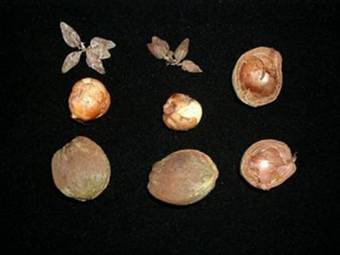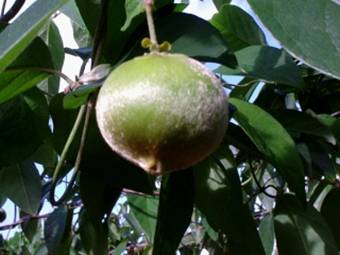DICELLA BRACTEOSA – DICELLA NUCIFERA
POPULAR NAMES: CASTANHA DE CIPÓ, AMENDOIM DE CIPÓ, CHESTNUT VINE, PEANUT VINE
MALPIGHIACEAE
|
DICELLA BRACTEOSA |
DICELLA NUCIFERA |
INDIGENOUS NAME: Guayaki manduví comes from the Tupi-Guarani and means "almond fruit that irritates" is derived from manduví-nut or peanut, yakí - to stick, which irritates the bristles at mention of the shell to penetrate the skin causing itching.
Origin: South America, Argentina, Paraguay and Atlantic Forest of southern Bahia to Rio Grande do Sul.
Characteristics: A climbing stem winder of vigorous growth, with simple, opposite and pubescentes (covered with hair), white on the underside. The flowers are forming in axillary racemes (small clusters) with flowers of 5 petals which are becoming from yellow to red after fertilization.
Planted in the site of Frutas Raras: October 2005, bear fruit for the first time in March 2007.
Tips
for cultivation:
Fast growing climbing plant
that resists low temperatures to -4°C (25°F)
and thrives from sea level to altitudes above
Propagation: The
seeds are fragile and therefore need not be removed from the husk or fruit
to germinate.
Germination occurs in
Planting: Can be
planted in full sun and shade in forests with large trees well spaced.
Space between
plants 4 x 4 m (13 feet).
The espalier should be made of 6
pillars in distances of
Cultivating:
Make only the formation of crown pruning and remove the shoots that were
grown from the base of the stem, the branches are to line out until they are fixed
at the espalier.
Fertilize with
organic compost, may be (4 liters) poultry litter + 50 g of NPK 10-10-10 in
the months of November and December, distributed them
to
Uses: The almonds resemble the taste of peanut, ideal for consuming in-natura. You should only be careful to remove the shell that has bristles that can enter the skin and cause irrigations.
Flowering in the site of Frutas Raras: November to March.
Fruiting in the site of Frutas Raras: February to May.
Back to the seedlist (English) or back to Malpighiaceae (Portuguese)

